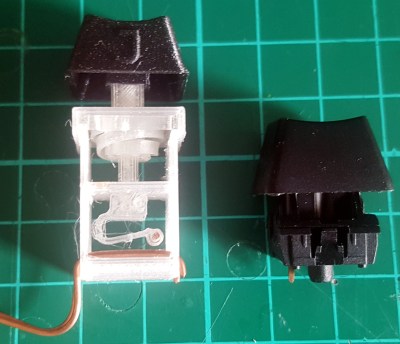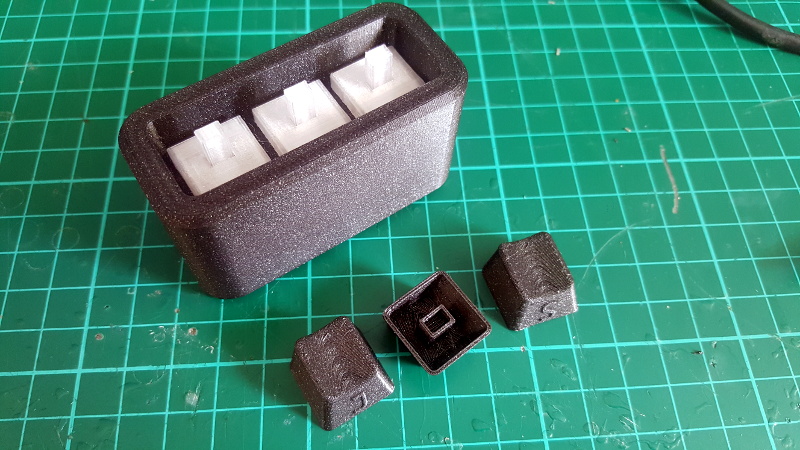Building a macro pad inside of a 3D printed enclosure is hardly news these days. Neither is adding 3D printed keycaps to the mix. But if you go as far as [James Stanley] has, and actually print the switches themselves, we’ve got to admit that’s another story entirely.
 Now you might be wondering how [James] managed to print a mechanical keyboard switch that’s the size of your garden variety Cherry. Well, the simple answer is that he didn’t. While his printed switches have the same footprint as traditional switches, they are twice as tall.
Now you might be wondering how [James] managed to print a mechanical keyboard switch that’s the size of your garden variety Cherry. Well, the simple answer is that he didn’t. While his printed switches have the same footprint as traditional switches, they are twice as tall.
The switches could probably made much smaller if it wasn’t for the printed spring, but using a “real” one would defeat the purpose. Though we do wonder if the mechanical design could be simplified by making it an optical switch.
But can printed switches really stand up to daily use? [James] wondered the same thing, so he built a testing rig that would hit the switches and count how many iterations before they stopped working. This testing seems to indicate that the keys will either fail quickly due to some mechanical defect, or last for hundreds of thousands of presses. So assuming you weed out the duds early, you should be in pretty good shape.
Naturally, there are a few bits of copper inside each printed switch to act as the actual contacts. But beyond that, all you need to build one of these printable pads yourself is a USB-HID capable microcontroller like the Arduino Pro Micro. If you used the ESP32, you could even make it Bluetooth.
















I’d be worried that copper will oxidize long term, effecting the reliability of the contact. Testing 100,000 presses in rapid succession shows absence of mechanical flaws that will kill it in 100,000 presses, but it doesnt in of it self show that the switch will work well after a long *time* in use.
If he used gold plated wire, then this would be less of an issue. However, I’ve never seen any such thing for sale.
Gold plated wire can actually be bought.
Typically used for making jewelry. The thickness of the gold plating varies a lot though depending on price and such.
how about just flowing a coating of solder over it?
solder is horrid for contacts that meet and break due to its structure (ie it fractures, hence why old computers need reflow on joints that have never been touched, but just going though heat cycles)
I also think that this can work.
I usually use gold plated pin from a header or a connector for anything that requires long term reliability.
Do not use the “gold” plated parts from China for this as *sometimes* they use a orange dye and the pins/connector oxidizes. Tin/solder plating should *never* be used for this
Just out of curiosity, why did you make an unsupported blanket statement against solder plating? Environmental concerns? Health concerns? Fire hazard? Personal preference?
I completely agree about gold plated parts from China. I’ve had those orange pins rust on some projects I’ve made. Similar results with Chinese “stainless steel” as well. It’s not very stainless.
Have you ever wonder why if Tin plated connector pins is good enough, why the heck they make gold plated ones for high reliability applications? Gold is chemically inert where as tin/lead aren’t. i.e. gold do not corrode while tin/lead will react with chemicals. e.g. oxygen, salt, impurities from left over flux etc.
Might want to learn your chemistry before accusing me.
Have you ever tried wiping something plated with solder after a couple of days? While it looks shiny, but it really isn’t. You’ll get a layer of black stuff on a tissue paper. After polishing, it gets shiny again, but will gradually tarnish.
Don’t take my word for it. Here is the support from experts.
https://experience.molex.com/gold-or-tin-versus-gold-and-tin/
>Besides these basic rules there are some other limitations where gold (or palladium nickel) must be used:
>For any type of analogue signals, gold is a must because of line noise created by tin plated contacts
>For any connector being exposed un-mated in the field in an industrial atmosphere
>For any connector with a contact spacing of less than 1mm because of whisker growth of pure tin-plated non annealed surfaces
>Especially the 3rd item created a lot of confusion in the industry when lead-free tin surfaces were introduced years ago.
>In summary, my first recommendation is to use gold-to-gold. Tin-to-tin may work but needs to be thoroughly tested for fretting corrosion, oxidation and IMC formation.
Where is *your* support?
Somebody woke up from the wrong side of the bed 😂
Jeez, calm down, John asked you a simple question and you’ve responded by blowing up in his face.
Probably work well to just use some spring contact pins. Good contact with some give for pressing and surface treated.
>USB-HID capable microcontroller like the
bah, there are numerous libraries for bit banging usb HID on 8-bit and other microcontrollers. There are code samples for PIC microcontrollers over at justanotherlanguage for example.
Silver is an alternative, the oxide is still a good conductor.
The metalurgy for relay contacts do not contsin any gold.
In traditional mechanical telephony exchange industry where you have a planned lifetime of switch contacts of 50+ years you do not see any goldplated contacts.
Just use galvanized steel like a paper clip. It’s fairly inert and you get extra DIY points.